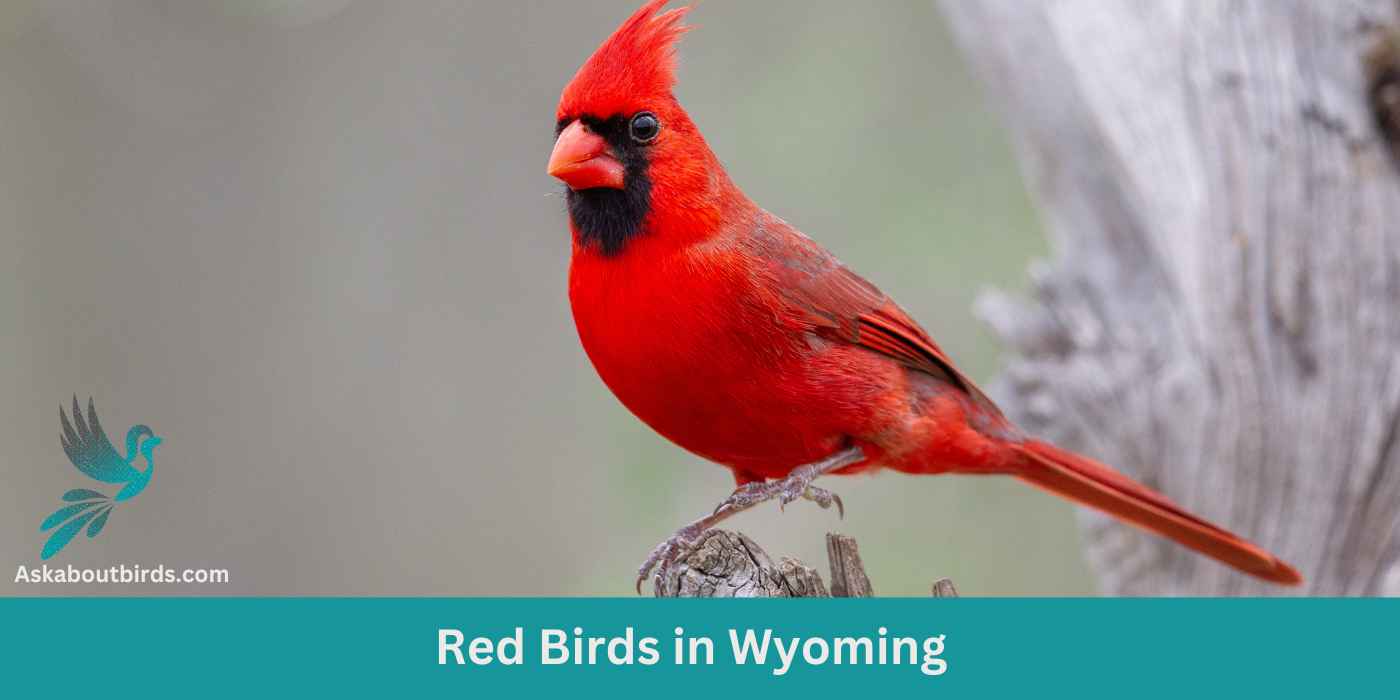Wide-open spaces, rugged mountain terrains, and serene plains make Wyoming a birder’s paradise. Among its feathered inhabitants, a select group stands out with vibrant shades of crimson and scarlet, captivating the eyes and hearts of every observer.
Dive into our guide and discover the 12 mesmerizing red birds in Wyoming plus get the added bonus of a comprehensive photo guide to make your birdwatching adventure even more rewarding.
Red Birds Found In Wyoming
The unique topographical tapestry of Wyoming provides various habitats, from alpine meadows to arid deserts, each with its own distinct ecosystem. This mosaic of habitats offers a plethora of food sources, nesting sites, and migratory stopovers for birds.
Its position at the crossroads of eastern and western North America means species from both regions can be found here. The convergence of these factors allows for remarkable avian diversity, making Wyoming a treasure trove for bird enthusiasts.
Northern Cardinal


| Feature | Measurement |
|---|---|
| Scientific Name | Cardinalis cardinalis |
| Length | 8.3 – 9.1 in |
| Wingspan | 9.8 – 12.2 in |
| Weight | 1.19 – 2.29 oz |
The Northern Cardinal is an iconic North American bird, easily recognized by its vibrant color and melodious song.
Appearance: Male Northern Cardinals are a brilliant scarlet red, while females display a more subdued reddish olive. Both sexes have a distinctive black ‘mask’ on their face around the bill and a pointed crest on their head. The bird’s beak is robust, cone-shaped, and bright orange in color.
Diet: Northern Cardinals are primarily granivorous, with a diet largely consisting of seeds and grains. They also eat fruits and insects. These birds typically feed off the ground and are frequent visitors to bird feeders.
Reproduction: Northern Cardinals are monogamous, and a pair will breed together for life. The female typically builds a well-hidden nest in a dense thicket or shrub. She lays 2-5 eggs per clutch, which she incubates for around two weeks.
Summer Tanager


| Feature | Measurement |
|---|---|
| Scientific Name | Piranga rubra |
| Length | 6.7 in |
| Wingspan | 28 to 30 cm |
| Weight | 29 g |
The Summer Tanager is a medium-sized songbird admired for its radiant plumage and melodious song.
Appearance: Male Summer Tanagers are an impressive bright red, while females and juveniles present a softer, yellow-orange color. Both genders have a large, slightly hooked bill and relatively short tail.
Diet: Summer Tanagers primarily feed on insects, including bees and wasps, which they catch in flight or pick off vegetation. They are also known to eat fruits and berries, making them helpful in controlling pest populations and seed dispersal.
Reproduction: The female Summer Tanager builds a loose, shallow cup-shaped nest out of twigs and grass, usually hidden in the foliage of trees. The female typically lays 3-5 eggs, which she will incubate for about two weeks.
Western Tanager

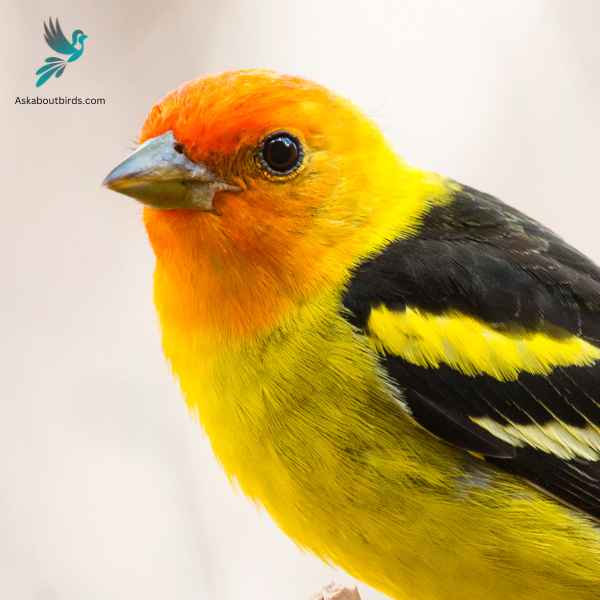
| Feature | Measurement |
|---|---|
| Scientific Name | Piranga ludoviciana |
| Length | 6.3-7.5 in |
| Wingspan | 11.5 in |
| Weight | 24-36 g |
The Western Tanager is a vibrant songbird that graces the forests and woodlands of the western regions of North America, enchanting observers with its colorful plumage and melodious song.
Appearance: The male Western Tanager is renowned for its bright yellow body contrasted with a striking red head and black wings and tail. The females are more subdued in hue, primarily being yellow with grayish wings and back, and lacking the brilliant red head of the males.
Diet: Western Tanagers primarily feed on insects, especially when breeding, but they also incorporate a significant amount of fruits and berries into their diet, especially during migration and winter.
Reproduction: Western Tanagers build their nests high in coniferous trees, often well concealed from potential predators. The female usually lays a clutch of 3 to 5 eggs and takes the primary role in incubation, while both parents are involved in feeding the chicks after they hatch.
House Finch


| Feature | Measurement |
|---|---|
| Scientific Name | Haemorhous mexicanus |
| Length | 5–6 in |
| Wingspan | 8–10 in |
| Weight | 0.6–0.9 oz |
The House Finch is a small songbird widely distributed across North America and is commonly found in urban and suburban areas.
Appearance: Males of this species are brightly colored with crimson faces and throats, which can extend to the chest and back, while their flanks have streaks. The female is streaked brown and lacks the red coloring. Both have a square-tipped tail and a distinctively long, flat-topped bill.
Diet: House Finches primarily eat seeds, grains, and berries. They have a particular fondness for sunflower seeds and can be commonly seen at bird feeders. Occasionally, they will also consume insects, especially during the breeding season.
Reproduction: House Finches are cavity-nesters and might choose ledges, vents, ledges, and other urban settings. They might also utilize trees or shrubs. Their nests can be made of a wide array of materials, from feathers to twigs.
Cassin’s Finch

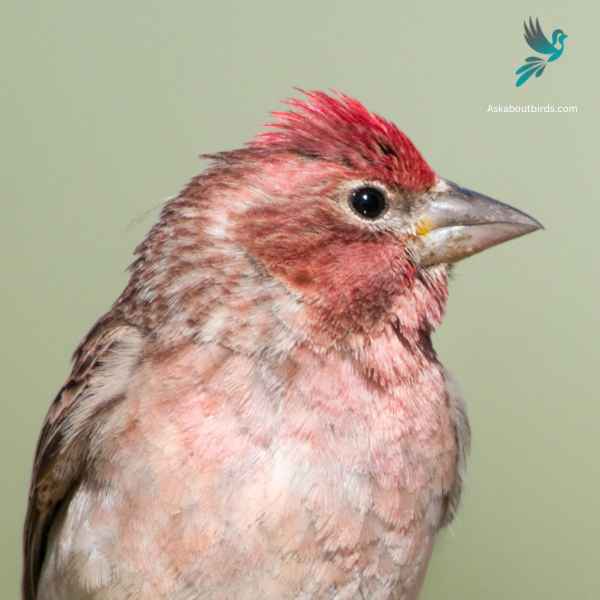
| Feature | Measurement |
|---|---|
| Scientific Name | Haemorhous cassinii |
| Length | 6.0-6.5 in |
| Wingspan | 9.5-10.5 in |
| Weight | 0.8-1.0 oz |
The Cassin’s Finch is a small songbird known for its melodic song and affinity for high-elevation forests.
Appearance: Male Cassin’s Finches are pinkish-red on the crown and throat, contrasting with their streaked brown back and wings. Females lack the bright coloring, appearing streaked brown throughout with a pale eyebrow stripe. Both sexes have a notched tail and a slightly curved bill.
Diet: Cassin’s Finches mainly feed on seeds, particularly from conifers. They also eat insects, especially during the breeding season. Their feeding habits often bring them to bird feeders where they readily eat sunflower seeds.
Reproduction: Cassin’s Finches nest in trees, preferring coniferous forests. The nest is made from twigs, grasses, and feathers. Typically, the female lays 3 to 5 eggs and handles most of the incubation. Both parents partake in feeding the fledglings once they hatch.
American Redstart


| Feature | Measurement |
|---|---|
| Scientific Name | Setophaga ruticilla |
| Length | 4.3 to 5.5 in |
| Wingspan | 6.3 to 9.1 in |
| Weight | 8.6 g |
The American Redstart is a lively warbler known for its vivid colors and active hunting style, often seen flitting about, fanning its tail to startle and catch insects.
Appearance: Adult male American Redstarts boast striking black plumage with bright orange patches on the sides, wings, and tail. Females and immature males have grayish-olive upperparts with yellow patches in the same areas where the males display orange.
Diet: American Redstarts are primarily insectivores. They actively forage for flying insects, as well as caterpillars and spiders, often using their colorful tails to startle prey and make them easier to catch.
Reproduction: The female American Redstart builds a cup-shaped nest in the fork of a tree branch. Typically, she lays a clutch of 3 to 5 eggs. The female takes on the primary responsibility of incubating the eggs, while both parents participate in feeding the fledglings after they hatch.
Vermilion Flycatcher
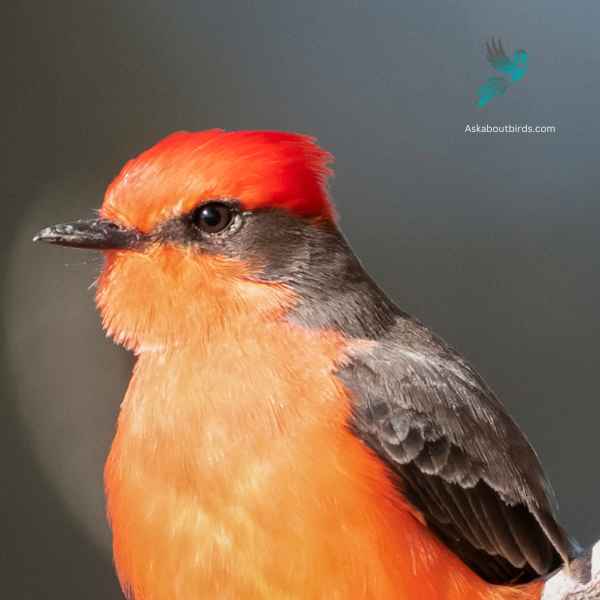

| Feature | Measurement |
|---|---|
| Scientific Name | Pyrocephalus obscurus |
| Length | 5.1–5.5 in |
| Wingspan | 9.4 to 9.8 in |
| Weight | 11 to 14 g |
The Vermilion Flycatcher is a small and colorful bird native to the Americas. The male Vermilion Flycatcher is a striking sight, displaying a vibrant red plumage on its head, breast, and underparts, contrasting with its brown wings and black tail below. Females, on the other hand, have more muted colors, featuring a pale yellowish belly and grayish-brown upperparts.
Vermilion Flycatchers are known for their lively and acrobatic flight displays, which they perform during courtship or to defend their territories. They often sing a series of soft, whistled notes while engaged in these aerial displays. They construct cup-shaped nests, usually in shrubs or low trees, where females lay their eggs and raise their young.
Red Crossbill

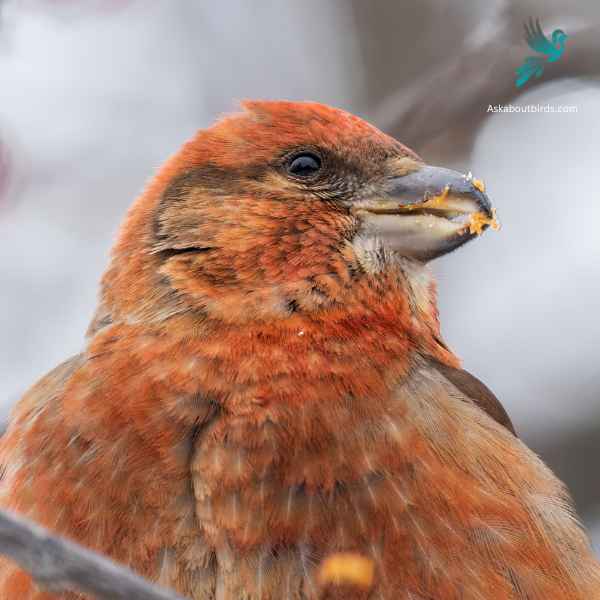
| Feature | Measurement |
|---|---|
| Scientific Name | Loxia curvirostra |
| Length | 5.5–7.5 in |
| Wingspan | 9.8–10.6 in |
| Weight | 0.9–1.4 oz |
The Red Crossbill is a distinctive finch known for its unusual bill, which has evolved to extract seeds from conifer cones.
Appearance: Males are typically bright red or orange, while females are greenish-yellow or olive. Both genders have the characteristic crossed bill, which they use to expertly extract seeds from tightly closed conifer cones.
Diet: Red Crossbills primarily feed on the seeds of coniferous trees, such as spruce, pine, and fir. Their specialized bills allow them to efficiently pry apart conifer cone scales to access the seeds.
Reproduction: Red Crossbills are somewhat nomadic and don’t adhere to a strict breeding schedule. Instead, they breed whenever and wherever food is abundant. Their nests are usually built on horizontal branches of conifer trees.
Pine Grosbeak

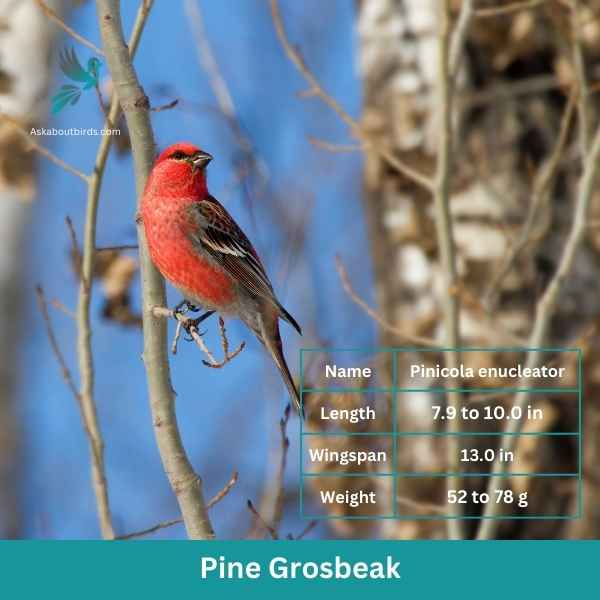
| Feature | Measurement |
|---|---|
| Scientific Name | Pinicola enucleator |
| Length | 7.9 to 10.0 in |
| Wingspan | 13.0 in |
| Weight | 52 to 78 g |
The Pine Grosbeak is a striking bird native to the northern regions of North America, often found in coniferous forests. Both males and females have a plump and robust body with a large beak adapted for eating seeds. The male Pine Grosbeak displays a vibrant reddish-pink plumage, while the female has a more subdued grayish-brown coloration.
These birds are typically seen in small flocks, foraging for food in trees and on the ground. They have a preference for seeds, particularly those from various conifer species. The Pine Grosbeak uses its strong bill to crack open the cones of tall trees and extract the seeds, but they also consume berries and small fruits when available.
Red-naped Sapsucker


| Feature | Measurement |
|---|---|
| Scientific Name | Sphyrapicus nuchalis |
| Length | 7.5-8.5 in |
| Wingspan | 16 in |
| Weight | 1.2-1.7 oz |
The Red-naped Sapsucker is a medium-sized woodpecker commonly found in forests across the western North America, especially in mixed coniferous woods and aspen groves.
Appearance: This woodpecker is distinguished by its black-and-white barred pattern on the back and wings. A key feature is the bright red patch on the back of the head, which gives the bird its name. Both sexes have a white stripe down the side of the face, though males have a red patch on the throat, whereas females have a white one.
Diet: Red-naped Sapsuckers are named for their habit of drilling rows of shallow holes into tree bark to feed on sap and the insects attracted to it. They also consume ants, beetles, and caterpillars, and will sometimes eat fruits and berries.
Reproduction: These woodpeckers excavate nest cavities in trees, often selecting dead or decaying trees or limbs. After carving out a cavity, the female typically lays a clutch of 4 to 7 eggs. Both parents share responsibilities for incubation and feeding the chicks once they hatch.
Rufous Hummingbird


| Feature | Measurement |
|---|---|
| Scientific Name | Selasphorus rufus |
| Length | 3.1–3.9 in |
| Wingspan | 4.3 in |
| Weight | 0.1–0.2 oz |
The Rufous Hummingbird is a small, brilliantly colored bird known for its impressive migratory journeys and feisty behavior.
Appearance: The male Rufous Hummingbird boasts a gleaming orange-red body with a white chest and an iridescent red throat, called a gorget. The female has green upperparts with rufous-washed flanks and tail. Her throat may have some iridescent patches, but it’s generally whitish.
Diet: Like other hummingbirds, the Rufous Hummingbird primarily feeds on nectar from a variety of flowering plants. They also eat insects and spiders for protein, catching them in flight or plucking them from vegetation.
Reproduction: Rufous Hummingbirds nest in trees, shrubs, or even ferns. The female alone selects the site, builds the nest, and cares for the offspring.
Broad-tailed Hummingbird
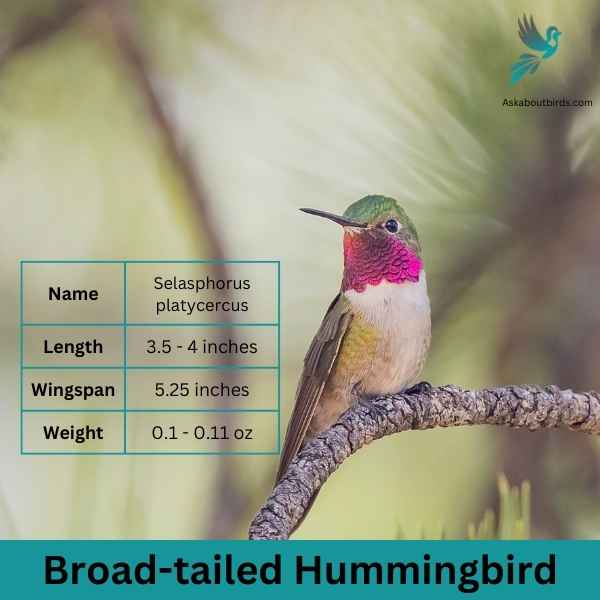
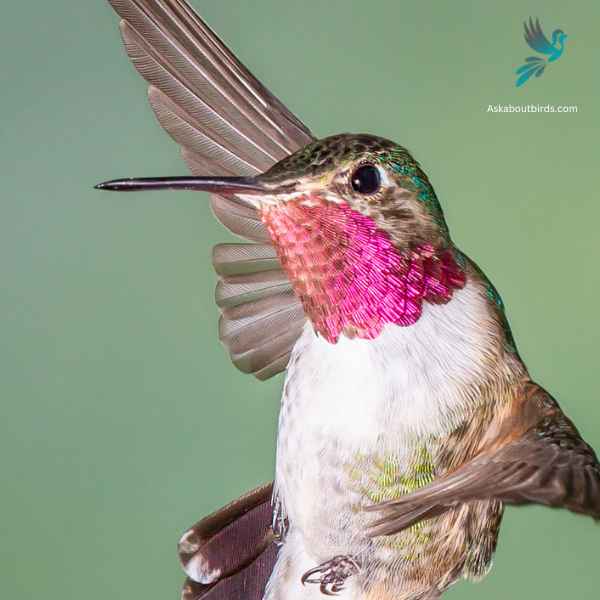
| Feature | Measurement |
|---|---|
| Scientific Name | Selasphorus platycercus |
| Length | 3.5 – 4 inches |
| Wingspan | 5.25 inches |
| Weight | 0.1 – 0.11 oz |
The Broad-tailed Hummingbird is a lively, small bird, identifiable by its iridescent colors and rapid wingbeats, often seen flitting around mountain meadows and gardens.
Appearance: This hummingbird showcases a dazzling green upper body, which in the right light, flashes with brilliant iridescence. Males possess a ruby-red throat, while females exhibit white underparts with green flanks and a white-tipped tail.
Diet: As nectar specialists, Broad-tailed Hummingbirds hover over flowers to sip nectar, acting as pollinators in the process. Additionally, their diet includes small insects and spiders, which provide necessary proteins.
Reproduction: The female is solely responsible for nest construction, which is often secured on a tree branch. This tiny cup-like nest is intricately woven using plant materials and spider webs, then adorned with lichens for camouflage. Inside, she lays typically two white eggs, then incubates and raises the chicks without any assistance from the male.
Where to Spot Wyoming’s Red Birds
Wyoming, with its myriad of habitats and stunning natural beauty, is a haven for birdwatchers. Here are some of the state’s prime locations for observing its rich avian tapestry:
- Yellowstone National Park – America’s first national park, is an iconic location that is not just famous for its geysers and wildlife, but also as a hotspot for diverse bird species, including many red-hued varieties.
- Seedskadee National Wildlife Refuge – Located along the Green River, this refuge attracts numerous migratory and breeding birds, making it a prime location for birdwatching, especially during spring and fall migrations.
- Bighorn Canyon National Recreation Area – The deep canyons and high cliffs provide nesting grounds for various raptor species, while the reservoir attracts waterfowl and other migratory birds.
- Medicine Bow-Routt National Forests – Spanning over two million acres, these forests provide a diverse habitat ranging from alpine meadows to dense woodlands, offering shelter to a vast array of bird species.
- Guernsey State Park – The reservoir and surrounding woodlands make this park a magnet for both waterfowl and forest-dwelling birds, providing birdwatchers with ample opportunities for sightings throughout the year.
| State’s Red Birds | Best Spots to See Red Birds |
|---|---|
| Montana’s Red birds | 1. Glacier National Park 2. Lee Metcalf National Wildlife Refuge 3. Charles M. Russell National Wildlife Refuge |
| South Dakota’s Red birds | 1. Badlands National Park 2. Black Hills National Forest 3. LaCreek National Wildlife Refuge |
| Nebraska’s Red birds | 1. Niobrara National Scenic River 2. Valentine National Wildlife Refuge 3. Crescent Lake National Wildlife Refuge |
| Colorado’s Red birds | 1. Rocky Mountain National Park 2. San Juan National Forest 3. Maroon Bells-Snowmass Wilderness |
| Utah’s Red birds | 1. Arches National Park 2. Bear River Migratory Bird Refuge 3. Zion National Park |
| Idaho’s Red birds | 1. Sawtooth National Recreation Area 2. Coeur d’Alene’s Old Mission State Park< 3. Deer Flat National Wildlife Refuge |
FAQs on Red Bird Species Found in Wyoming
What are the distinguishing features of birds with dark gray wings?
Birds with dark gray wings, often seen in both the northern and western states as well as the southern and eastern states, present a captivating sight. This coloration contrasts with other features like bright blue heads or dull orange heads. While tail feathers might vary, those with white wing patches or bars stand out prominently against the gray wings. It’s common for these birds to frequent forest edges or dense vegetation, and they might be a regular or an accidental or rare species in certain regions.
How do white winged crossbills adapt to their environment?
The white winged crossbill, predominantly found in evergreen forests and mixed forests of the northern states, showcases an impressive adaptability. Their beak, designed for breaking unopened pine cones, aids them in extracting conifer seeds, their primary diet. Their vibrant birds, with darker wings and characteristic white wing bars, often blend seamlessly with pine grosbeaks in pine forests. Central and South America also record their presence, particularly in areas dense with conifer trees.
Are painted buntings common in southern Florida?
Painted buntings, especially the males with their green wings and vibrant hues, are indeed spotted in regions like southern Florida. Their love for shade trees, berry plants, and forest edges makes them a sight to behold in wooded habitats. Bird enthusiasts often attract these magnificent birds with backyard feeders filled with black oil sunflower seeds. Their striking contrast of colors, from the dull orange heads to the bright body, makes them a favorite among birdwatchers.
How can one attract pine grosbeaks to their backyard?
Pine grosbeaks, with their brown plumage and occasional white stripes, are known to frequent both pine forests and eastern forests. Their fondness for berry bushes, fruit trees, and pine cones make them a delightful sight in mixed forests. To attract these birds, especially in the northern states, one can set up large tube feeders or sunflower seed feeders stocked with black oil sunflower seeds in their backyard. Their characteristic songs and visits can turn any backyard into a birdwatching paradise.

